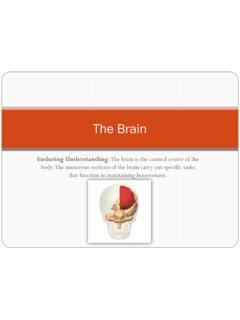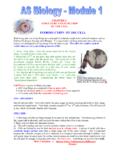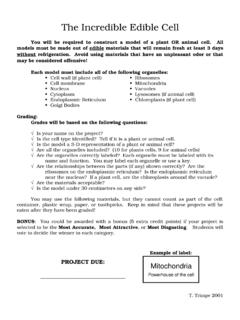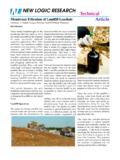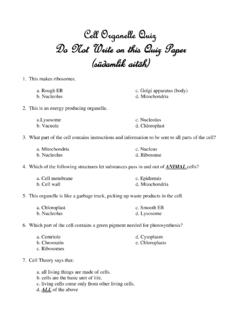Transcription of Cell Membrane Permeability Introduction - icuf.org
1 Cell Membrane Permeability Names:_____. _____. Date:_____. Introduction : The Membrane of a cell is only two molecules thick, but it is of incredible importance in terms of the evolution of life on the planet as we know it. The plasma Membrane is composed of two layers of phospholipids, special molecules that Figure 1: Lipid are kind of confused, with a hydrophilic bilayer, with head group (the phosphate end) and a chemical hydrophobic tail end (made of fatty acid structures chains). These molecules organize into a indicated. Figure from bilayer, with the head groups facing Wikipedia, toward the outside and the inside of the accessed on cell, and the lipid tails pointing towards June 14, 2012.
2 Each other (Figure 1). The amphipathic nature of these molecules define the role of the Membrane , to allow for the separation of self from non-self and the specialization of organelles inside the plasma Membrane of the cell to perform functions that could otherwise be toxic to the cell. Also, membranes are important components of how the cell makes energy (remember cellular respiration and the proton gradient that makes ATP) from glucose, and glucose from the light of the sun during photosynthesis in plants. Because of the hydrophobic interior of the cell Membrane (Figure 1), materials that are hydrophobic themselves can cross the Membrane ( like dissolves like ).
3 Polar or charged molecules have a difficult time crossing the Membrane because of the hydrophobic core water molecules hydrate the surface of polar molecules, and the hydrophobic core of the Membrane strongly resists water. Functional groups like hydroxyl groups (OH) increase the polarity of molecules, and the more hydroxyls a molecule has the more polar it will be. The more polar the molecule, the less likely it will be to cross. This information will be useful when you work through your hypotheses below. However, there are other factors like the size of molecules that can affect whether it will cross, with large molecules having a more difficult time crossing than smaller molecules.
4 To investigate this, comparing molecules that have Figure 2: Human red blood cells , 6-8 CH2O in that rough ratio (the sugars, from methanol to sucrose). microns. Photo from Wikipedia, date could be useful. Then there are molecules that have a shape like accessed June 15, 2012. 1. the phospholipids that work better than they do and work to dissolve the Membrane itself and surround the pieces of Membrane with chemical to wash the membranes away. Your job today is to work with a list of chemicals, many of them available in your household, to determine which of them will cross a biological Membrane and which of them won't.
5 The membranes you will use in the lab are the membranes of red blood cells (RBC's), simple cells that basically consist of Membrane and hemoglobin proteins inside. In mammals, these cells don't have a nucleus or any Membrane bound organelles inside, and so don't use the oxygen that they are so important for transmitting around the body. The energy inside these red blood cells is made completely from glycolysis to make ATP with NADH recycled to NAD+ by creating lactic acid from pyruvate during the lactic acid fermentation process. We recommend that to prepare for this lab, that you read up on red blood cells in your textbook and other sources (such as ).
6 The internal concentration of RBC's is approximately 300. mOsm, or about Most of the solutions we have prepared for you are at , and as a result, these solutions will be iso-osmotic with the internal environment of the cell. If a material can cross the Membrane of the red blood cell, then it will cross and will cause the cell to lyse, dumping its contents. If the chemical cannot cross, then the cell will not lyse because the internal and external concentration of solutes is the same across the Membrane . Some of the materials we have given you to test ionize in the watery (aqueous). environment of the cell, and as a result, may have a higher than concentration and you might observe a different response.
7 Use this information to think through the development of your hypotheses below. Hypothesis formation: For the first part of this laboratory, you are to look at the page of chemical structures provided as a handout, think about what those chemicals would do inside the watery (aqueous). environment of the cell. Would they break apart and ionize? What effect would water have interacting with these chemicals? For each compound, you need to think about and write down what the material would do in water, and if the compound or its components would be able to cross the red blood cell Membrane . If you determine that a material can't cross the Membrane , then what would the water inside the cell do in the environment of that solution (if you add the solution to the outside of the cell Membrane )?
8 In thinking about your hypotheses, you must consider the 1. Hydrophobicity of the molecule (is it charged, polar or nonpolar in the aqueous environment of the cell?). List here what you remember from the section of the course on chemistry, regarding what functional groups/elements you should look for to determine if a molecule is polar, nonpolar, or charged. 2. Size of the molecule (is it large or small? Are the atoms similar between molecules, just higher numbers of atoms in the larger molecules?). What do you look for to determine the size of a molecule? 3. Shape of the molecule (does the molecule look like a phospholipid?)
9 Describe and draw what a phospholipid looks like here: 2. Before you create your hypotheses, first put the molecules on your chemical structure sheet into as many different groupings as possible, and describe the criteria that organizes each of your groups (for example, will behave like a salt and ionize in a normal cell). Develop at least 4 different groupings, below: Group 1: _____ Group 2:_____. Group 3: _____ Group 4:_____. Next, form your hypotheses as to whether these materials will cross the Membrane , and provide explanations for your hypotheses. In the explanation column, you can/should also draw what you think the cells will do when provided with the chemical.
10 Compound Mol. Wt. M/L Hypothesis Explanation Distilled Water (H20). Methanol (CH3OH) Sodium Laureth Sulfate (dishwashing liquid). Ammonium Sulfate (NH4)2SO4. Acetic Acid (vinegar). (CH3 COOH). NaCl (table salt) 3. NaCl Ethylene Glycol (antifreeze). (HOC2H4OH). Isopropanol (rubbing alcohol;. C3H8O). Glycerol (C3H8O3). Dextrose (C6H12O6). Sucrose (C12H22O11). Butane (C4H10) Procedure for testing your hypotheses: 1. Materials Needed: a. Compound microscopes for students b. Slides c. Cover slips d. Stopwatch e. Red blood cells f. Transfer pipets g. Very small containers for solutions; eyedropper bottles to be passed around the lab would work too, and would reduce the need for transfer pipets h.
